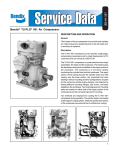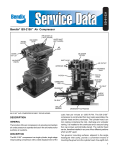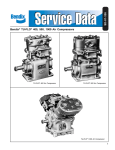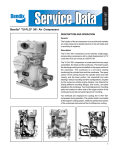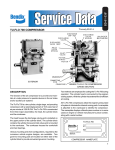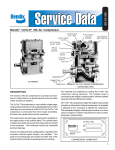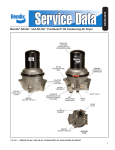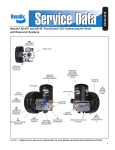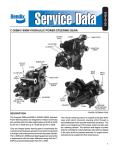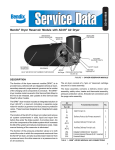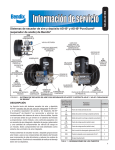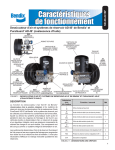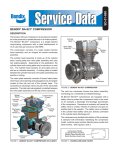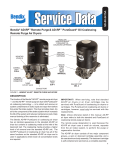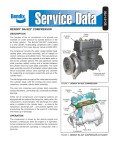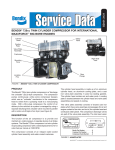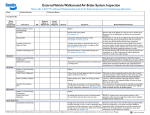Download BENDIX SD-01-331 User's Manual
Transcript
SD-01-331 ® Bendix® BX-2150™ Air Compressor AIR OUTLET (2) (1 NOT SHOWN) WATER OUTLET UNLOADER STOP WATER INLET (NOT SHOWN) AIR INLET UNLOADER PISTON WATER OUTLET INLET VALVE UNLOADER PORTS AIR OUTLET AIR INTAKE DISCHARGE VALVE PISTON RINGS PISTON REAR END COVER CONNECTING ROD OIL INLET CRANKSHAFT SLEEVE BEARING OIL SEAL ROLLER BEARING BX-2150™ AIR COMPRESSOR BELT DRIVE MODEL DESCRIPTION GENERAL The function of the air compressor is to provide and maintain air under pressure to operate devices in the air brake and/or auxiliary air systems. DESCRIPTION The BX-2150™ compressor is a single cylinder, single stage reciprocating compressor with a rated displacement of 9.5 CRANKSHAFT OIL PASSAGE cubic feet per minute at 1250 R.P.M. The BX-2150™ compressor is constructed from two major assemblies, the cylinder head and the crankcase. The cylinder head is an iron casting containing the inlet, discharge and unloader valving. It is installed on the crankcase and is secured using four cap screws symmetrically placed. The cylinder head can be, therefore installed in any one of four different positions which are 90° apart. Two governor mounting surfaces, adjacent to the single rectangular inlet cavity, provide a convenient means of mounting the governor to the cylinder head. One eighth inch 1 1/2” P.T. WATER PORT (3) OUTLET WATER ONLY PART NUMBER 1/2” P.T. AIR DISCHARGE (2) SERIAL NUMBER TYPICAL NAMEPLATE 1/8” P.T. GOVERNOR PORT 2 PLACES AIR INLET 1/2” P.T. WATER PORT BX-2150™ COMPRESSOR CYLINDER HEAD pipe threads in each of the two governor mounting pads allow plugging of the unused port or the installation of a tubing fitting for remote governor mounting. Three 1/2” N.P.T. ports provide the means for the connection of coolant lines and are labeled WATER. Two 1/2” N.P.T. discharge ports are located on the top and side of the cylinder head and are labeled AIR OUT. The various mounting and drive configurations required by the numerous vehicle engine designs are accommodated by different crankcase castings and crankshafts. Two methods for cooling the BX-2150™ compressor are employed. The cylinder head is water cooled using the engine’s cooling system, while external fins on the crankcase provide a means for efficient air cooling in that area. All BX-2150™ compressors utilize the engine’s pressurized oil system to lubricate internal moving parts. A nameplate attached to the compressor crankcase identifies the compressor model and is stamped to indicate the Bendix part number and serial number. compression of air is controlled by the compressor unloading mechanism and the governor. The governor is generally mounted on the compressor and maintains the brake system air pressure between a preset maximum and minimum pressure level. INTAKE AND COMPRESSION OF AIR (LOADED) During the down stroke of the piston, a slight vacuum is created between the top of the piston and the head, causing the flat circular inlet valve to move off its seat. (Note the flat square discharge valve remains on its seat.) Atmospheric air is drawn into the intake cavity and flows past the open inlet valve and into the cylinder (See Figure 1). As the piston begins its upward stroke, the air that was drawn into the cylinder on the down strike is compressed . Air pressure on the inlet valve plus the force of its spring, returns the inlet valve to its seat. As the piston continues its upward stroke, air is compressed and forces the discharge valve away from its seat. Air flows past the open discharge valve into the discharge line and on to the reservoirs. (See Figure 2) As the piston reaches the top of its stroke and starts down, the discharge valve spring and air pressure in the discharge line returns the discharge valve to its seat. This prevents the compressed air in the discharge line from returning to the OPERATION GENERAL The compressor is driven by the vehicle engine and is operating continuously while the engine is running. Actual VALVE STOP UNLOADER PISTON TO RESERVOIR INTAKE INLET VALVE VIEW DISCHARGE VALVE PISTON INTAKE CYCLE COMPRESSOR MOUNTING/DRIVE CONFIGURATIONS 2 FIGURE 1 VALVE STOP UNLOADER PISTON INLET INLET VALVE TO RESERVOIR DISCHARGE VALVE PISTON FIGURE 2 - COMPRESSION/DISCHARGE CYCLE cylinder bore as the intake and compression cycle is repeated. NON-COMPRESSION OF AIR (UNLOADED) When air pressure in the reservoir reaches the cut-out setting of the governor, the governor allows air to flow from the reservoir into the unloader piston cavity. The unloader piston moves, in response to air pressure and drives the inlet valve away from its seat and holds it against its stop. With the inlet valve held away from its seat, air compression is stopped and air is free to move back and forth past the inlet valve in response to piston travel. System pressure will eventually drop to the cut-in pressure setting of the governor due to air usage. When the cut-in pressure is reached, the governor responds by exhausting air from the unloader piston cavity. Spring force moves the unloader piston away from the inlet valve and compression is resumed as the inlet valve returns to its seat. COMPRESSOR & THE AIR BRAKE SYSTEM GENERAL The compressor is part of the total air brake system, more specifically, the charging portion of the air brake system. As a component in the overall system its condition, duty cycle, proper installation and operation will directly affect other components in the system. Powered by the vehicle engine, the air compressor builds the air pressure for the air brake system. The air compressor is typically cooled by the engine coolant system, lubricated by the engine oil supply and has its inlet connected to the engine induction system. As the atmospheric air is compressed, all the water vapor originally in the air is carried along into the air system, as well as a small amount of the lubricating oil as vapor. If an air dryer is not used to remove these contaminants prior to entering the air system, the majority, but not all, will condense in the reservoirs. The quantity of contaminants that reach the air system depends on several factors including installation, maintenance and contaminant handling devices in the system. These contaminants must either be eliminated prior to entering the air system or after they enter. DUTY CYCLE The duty cycle is the ratio of time the compressor spends building air to the total engine running time. Air compressors are designed to build air (run "loaded") up to 25% of the time. Higher duty cycles cause conditions that affect air brake charging system performance which may require additional maintenance. Factors that add to the duty cycle are: air suspension, additional air accessories, use of an undersized compressor, frequent stops, excessive leakage from fittings, connections, lines, chambers or valves, etc. Refer to Table A in the Troubleshooting section for a guide to various duty cycles and the consideration that must be given to maintenance of other components. COMPRESSOR INSTALLATION UNLOADER PISTON INLET INLET VALVE VALVE STOP TO RESERVOIR DISCHARGE VALVE PISTON FIGURE 3 - UNLOADED CYCLE While the original compressor installation is usually completed by the vehicle manufacturer, conditions of operation and maintenance may require additional consideration. The following presents base guidelines. DISCHARGE LINE The discharge line allows the air, water-vapor and oil-vapor mixture to cool between the compressor and air dryer or reservoir. The typical size of a vehicle's discharge line, (see column 2 of Table A in the Troubleshooting section) assumes a compressor with a normal (less than 25%) duty cycle, operating in a temperate climate. See Bendix and/or other air dryer manufacturer guidelines as needed. The discharge line must maintain a constant slope down from the compressor to the air dryer inlet fitting or reservoir to avoid low points where ice may form and block the flow. If, 3 The Air Brake Charging System supplies the Discharge Line Optional “Ping” Tank Air Dryer compressed air for the braking system as well as other air accessories for the vehicle. The system usually consists of an air compressor, governor, discharge line, air dryer, and service reservoir. Optional Bendix® PuraGuard® QC™ Oil Coalescing Filter Compressor Governor (Governor plus Synchro valve for the Bendix® DuraFlo™ 596 Compressor) Service Reservoir (Supply Reservoir) Reservoir Drain FIGURE 4A - SYSTEM DRAWING instead, ice blockages occur at the air dryer or reservoir inlet, insulation may be added here, or if the inlet fitting is a typical 90 degree fitting, it may be changed to a straight or 45 degree fitting. Shorter discharge line lengths or insulation may be required in cold climates. While not all compressors and charging systems are equipped with a discharge line safety valve this component is recommended. The discharge line safety valve is installed in the cylinder head or close to the compressor discharge port and protects against over pressurizing the compressor in the event of a discharge line freezeup. HOLE DISCHARGE LINE TEMPERATURE When the temperature of the compressed air that enters the air dryer is within the normal range, the air dryer can remove most of the charging system oil. If the temperature of the compressed air is above the normal range, oil as oilvapor is able to pass through the air dryer and into the air system. Larger diameter discharge lines and/or longer discharge line lengths can help reduce the temperature. The air dryer contains a filter that collects oil droplets, and a desiccant bed that removes almost all of the remaining water vapor. The compressed air is then passed to the air brake service (supply) reservoir. The oil droplets and the water collected are automatically purged when the governor reaches its "cut-out" setting. For vehicles with accessories that are sensitive to small amounts of oil, we recommend installation of a Bendix® PuraGuard® QC™ oil coalescing filter, designed to minimize the amount of oil present. LUBRICATION THREAD FIGURE 4B - DISCHARGE LINE SAFETY VALVE 4 All BX-2150™ compressors are connected to the engine’s pressurized oil system and a continuous flow of oil is provided to the compressor, which is eventually returned to the engine. Oil is fed into the compressor in various ways, for example; through the rear end cover or the drive end of the crankshaft. An oil passage in the crankshaft conducts pressurized oil to the precision sleeve main bearings and to the connecting rod bearing. The cylinder bore, connecting rod wrist pin bushing and ball type main bearing, where used, are splash lubricated. Splash lubrication is obtained as oil is forced out around the crankshaft journals by engine oil pressure. See the tabulated technical data in the back of this manual for specific requirements. OLD STYLE HEAD ADAPTER REQUIRED GASKET 243430 INLET ADAPTER 297871 COOLING Air flowing through the engine compartment from the action of the engine’s fan and the movement of the vehicle assists in cooling the crankcase. Coolant flowing from the engine’s cooling system through connecting lines enters the head and passes through the head’s water jacket and back to the engine. Proper cooling is important in maintaining discharge air temperatures below the maximum 400°F recommended. Figure 5 illustrates the various approved coolant flow directions. See the tabulated technical data in the back of this manual for specific requirements. INLET CHECK VALVE KIT 104670 FAILURE TO INSTALL ADAPTER 297871 WHEN USING AN INLET CHECK VALVE WITH THIS STYLE HEAD... WILL RESULT IN COMPRESSOR DAMAGE NEW STYLE HEAD IDENTIFY NEW HEAD BY NOTING PRESENCE OF PLUGGED BOSS HERE ADAPTER NOT REQUIRED PLUG IN OUT INLET CHECK VALVE KIT 104670 FIGURE 6 OUT PLUG INLET CHECK VALVE PLUG OUT IN IN FIGURE 5 - WATER CONNECTIONS/FLOW AIR INDUCTION GENERAL There are three methods of providing clean air to the BX-2150™ compressor; 1. Naturally aspirated Local Air Strainer - Compressor utilizes its own attached air strainer (polyurethane sponge or pleated paper dry element). 2. Naturally aspirated Engine Air Cleaner - Compressor inlet is connected to the engine air cleaner or the vacuum side (engine air cleaner) of the supercharger or turbocharger. 3. Pressurized induction - Compressor inlet is connected to the pressure side of the supercharger or turbocharger. See the tabulated technical data in the back of this manual for specific requirements for numbers 2 and 3 above. An inlet check valve is used on some naturally aspirated BX-2150™ compressors (never with pressurized induction, see #3 above) to prevent inlet oil misting during the unloaded cycle. The new style BX-2150™ compressor head (See Figure 6) can be identified by the plugged boss on the upper right hand side. This head only requires kit 104670 to install an inlet check valve. All other old style BX-2150™ compressor heads (See Figure 6) require the use of the inlet adapter 297871 and inlet gasket 243430 in addition to the kit 104670. WARNING! FAILURE TO INSTALL ADAPTER 297871 WHEN REQUIRED WILL RESULT IN COMPRESSOR DAMAGE. The inlet check valve consists of three parts, the inlet gasket, the inlet check valve reed and the inlet check valve seat (See Figure 6) during the compression cycle, the inlet check valve reed is drawn away from its seat uncovering three inlet holes which allows air to flow into the compressor inlet cavity. A machined stop in the cylinder head inlet cavity or in the inlet adapter 297871 limits the travel of the inlet check valve reed. In the unloaded cycle, the inlet check valve reed rests on its seat covering the three inlet holes. Air from within the compressor is prevented from exiting the inlet cavity. 5 Inlet gasket 243430 is required between the inlet check valve reed and the inlet cavity of new style heads, or between the inlet check valve reed and the inlet adapter 297871 for old style heads, as its thickness contributes to the minimum reed travel required. The pin in the check valve seat must align with the holes in the check valve, the inlet gasket and enter the mating hole in the head or the inlet adapter. (Refer to Figure 6) CAUTION: If ICV is used with air dryer/aftercooler which vents the discharge line during its purge cycle, a PR-4™ valve (P/N 103976) is recommended to be installed in the discharge line to minimize oil passing which can occur in the combined use of an ICV and a vented discharge line. See Bulletin No. PRO-08-13 for proper installation of the PR-4™ valve. PREVENTATIVE MAINTENANCE Regularly scheduled maintenance is the single most important factor in maintaining the air brake charging system. Refer to Table A in the Troubleshooting section for a guide to various considerations that must be given to the maintenance of the compressor and other related charging system components. AIR INDUCTION One of the single most important aspects of compressor preventive maintenance is the induction of clean air. The type and interval of maintenance required will vary depending upon the air induction system used. The intervals listed under the headings below pertain to typical highway and street operation. More frequent maintenance will be required for operation in dusty or dirty environments. POLYURETHANE SPONGE STRAINER Every month, 150 operating hours or 5,000 miles, whichever occurs first, remove and wash all of the parts. RD. HD. MACHINE SCREW SCREW COVER COVER ASSEMBLY FILTER ELEMENT BAFFLE MOUNTING BAFFLE FILTER ELEMENT COVER FIGURE 8 The strainer element should be cleaned or replaced. If the element is cleaned, it should be washed in a commercial solvent or a detergent and water solution. The element should be saturated in clean engine oil, then squeezed dry before replacing it in the strainer. Be sure to replace the air strainer gasket if the entire air strainer is removed from the compressor intake. DRY ELEMENT-PLEATED PAPER AIR STRAINER Every two months, 800 operating hours or 20,000 miles whichever occurs first, remove the spring clips from either side of mounting baffle and remove the cover. Replace the pleated paper filter and remount the cleaned cover making sure the filter is in position. Make certain to replace the air strainer gasket if the entire air strainer is removed from the compressor intake. INTAKE ADAPTER When the engine air cleaner is replaced; Some compressors are fitted with intake adapters which allow the compressor intake to be connected to the engine air cleaner, turbo or super-charger. In this case, the compressor receives a supply of clean air from the engine air cleaner. When the engine air filter is changed, the compressor intake adapter should be checked. If it is loose, remove the intake adapter, clean the strainer plate, if applicable, and replace the intake adapter gasket, and reinstall the adapter securely. Check line connections both at the compressor intake adapter and at the engine or engine air cleaner. Inspect the connecting line for kinks and ruptures and replace it if necessary. STRAINER SCREW BODY BAFFLE GASKET BASE PLATE FIGURE 7 6 FIGURE 9 - COMPRESSOR INTAKE ADAPTER COMPRESSOR COOLING Every six months, 1800 operating hours or 50,000 miles, whichever occurs first, inspect the compressor discharge port, inlet cavity and discharge line for evidence of restrictions and carboning. If excessive buildup is noted, thoroughly clean or replace the affected parts and closely inspect the compressor cooling system. Check all compressor coolant lines for kinks and restrictions to flow. Minimum coolant line size is 3/8" I.D. Check coolant lines for internal clogging from rust scale. If coolant lines appear suspicious, check the coolant flow and compare to the tabulated technical data present in the back of this manual. Inspect and clean the external air cooling fins on the cylinder portion of the crankcase. If fins are cracked or broken, replace the compressor. Inspect the air induction system for restrictions. LUBRICATION Every six months, 1800 operating hours or 50,000 miles, whichever occurs first; check external oil supply and return lines, if applicable, for kinks, bends, or restrictions to flow. Supply lines must be a minimum of 3/16" I.D. and return lines must be a minimum of 1/2" I.D. Oil return lines should slope as sharply as possible back to the engine crankcase and should have as few fittings and bends as possible. Refer to the tabulated technical data in the back of this manual for oil pressure minimum valves. Check the exterior of the compressor for the presence of oil seepage and refer to the TROUBLESHOOTING section for appropriate tests and corrective action. OIL PASSING All reciprocating compressors currently manufactured will pass a minimal amount of oil. Air dryers will remove the majority of oil prior to entrance into the air brake system. For particularly oil sensitive systems the Bendix® PuraGuard® QC™ oil coalescing filter can be used in conjunction with a Bendix air dryer. If compressor oil passing is suspected, refer to the TROUBLESHOOTING section and TABLE A for the symptoms and corrective action to be taken. In addition, Bendix has developed the "Bendix Air System Inspection Cup" or BASIC test to help substantiate suspected excessive oil passing. The steps to be followed when using the BASIC test are presented in APPENDIX A at the end of the TROUBLESHOOTING section. COMPRESSOR DRIVE Every six months, 1800 operating hours or 50,000 miles, whichever occurs first, check for noisy compressor operation. Variations in noise level in conjunction with the compression and unloaded cycles generally indicate loose or worn drive components. On belt drive compressors check for pulley and belt alignment and tension. Adjust as necessary, paying particular attention not to overtighten belt tension. Check for loose and out of aligned pulleys. Adjust or replace as necessary. Compressor crankshaft keyway damage indicates a loose pulley and often requires compressor replacement. Main bearing failures on belt driven compressors often indicate excessive belt tension. A thorough inspection, and possible replacement, of drive components should be made at each compressor change. Special attention should be given to drive gears and couplings on compressors which have been operated at high discharge pressures due to a blocked or frozen discharge line. Check all compressor mounting bolts and retighten evenly as necessary. Check the condition of all compressor mounting bracketry, tighten hardware as necessary, and replace if damaged. OPERATIONAL TESTS Every three months, 900 operating hours or 25,000 miles whichever occurs first. Vehicles manufactured after the effective date of FMVSS 121, with the minimum required reservoir volume, must have a compressor capable of raising air system pressure from 85-100 p.s.i. in 25 seconds or less. This test is performed with the engine operating at maximum governed speed. The vehicle manufacturer must certify this performance on new vehicles with appropriate allowances for air systems with greater than the minimum required reservoir volume. Check unloader operation by building system pressure to governor cut-out and note that air compression stops. Reduce system pressure to governor cut-in and note that air compression resumes. If the compressor fails to respond as described, make certain the governor is functioning properly before repairing or replacing the compressor. COMPRESSOR AIR LEAKAGE TESTS Compressor leakage tests need not be performed on a regular basis. These tests should be performed when; it is suspected that discharge valve leakage is substantially affecting compressor build-up performance, or when it is suspected that the compressor is “cycling” between the load and unloaded modes due to unloader piston leakage. These tests must be performed with vehicle parked on a level surface, the engine not running, the entire air system completely drained to 0 P.S.I., and the inlet check valve detail parts removed, if applicable. UNLOADER PISTON LEAKAGE Remove the governor and apply shop air pressure to the 1/8" pipe thread unloader port on the governor mounting pad. Listen for the escape of air at the inlet cavity. An audible escape of air should not be detected. If any question exists 7 NO. 11 1 2 3 4 5 6 7 8 9 10 11 12 13 14 15 16 17 18 19 20 12 1 13 CYLINDER HEAD ASSY. 2 3 14 4 15 5 16 6 7 17 18 8 9 10 19 20 21 21 22 20 23 24 25 22 CRANKCASE FRONT BALL CRANKSHAFT BEARING CRANKSHAFT KEY 23 DESCRIPTION Cylinder Head Assembly Governor Gasket Unloader Bushing O-Ring Unloader Piston Unloader Spring Inlet Valve Gasket Inlet Valve Seat Inlet Valve Inlet Valve Spring Inlet Valve Stop Unloader Piston Stop Hex Head Screws O-Ring Inlet Strainer Gasket Discharge Valve Stop Discharge Valve Spring Discharge Valve Discharge Valve Seat Cylinder Head Gasket Piston Ring Set (STD) #1 Piston Ring #2 Piston Ring Piston Ring Oil Expander Ring Piston Wrist Pin Plug Wrist Pin Connecting Rod Connecting Rod Cap Lockwasher Connecting Rod Bolt O-Ring Thrust Washer End Cover Assembly 5/16” MACH.SCREW WITH LOCKWASHER OIL SEAL 24 25 DRIVE SCREWS CRANKSHAFT NUT NAME PLATE 22 8 NOTE: SOME APPLICATIONS USE FRONT AND REAR REF. SOME FLANGE MOUNTS WITHOUT BALL BEARINGS. as to leakage, it is recommended that a genuine Bendix unloader kit be installed and the cylinder head retested. DISCHARGE VALVE LEAKAGE Unloader piston leakage must be repaired before this test is performed. Leakage past the discharge valve can be detected by removing the discharge line, applying shop air to the unloader mechanism and the discharge port and listening for the escape of air at the compressor inlet cavity. A barely audible escape of air is generally acceptable; however, if there is any question as to the leakage rate, it is recommended that the cylinder head or compressor be removed and repaired or replaced. With shop air still applied at the discharge port, apply a soap solution to the valve stop recess on the top of the head. If leakage is detected, the cylinder head must be repaired or replaced. Only genuine Bendix remanufactured compressors or service parts and kits should be used. COMPRESSOR TROUBLESHOOTING IMPORTANT: The troubleshooting contained in this section considers the compressor as an integrated component of the overall air brake charging system and assumes that an air dryer is in use. The troubleshooting presented will cover not only the compressor itself, but also other charging system devices as they relate to the compressor. WARNING! PLEASE READ AND FOLLOW THESE INSTRUCTIONS TO AVOID PERSONAL INJURY OR DEATH: When working on or around a vehicle, the following general precautions should be observed at all times. 1. Park the vehicle on a level surface, apply the parking brakes, and always block the wheels. Always wear safety glasses. 2. Stop the engine and remove ignition key when working under or around the vehicle. When working in the engine compartment, the engine should be shut off and the ignition key should be removed. Where circumstances require that the engine be in operation, EXTREME CAUTION should be used to prevent personal injury resulting from contact with moving, rotating, leaking, heated or electrically charged components. 3. Do not attempt to install, remove, disassemble or assemble a component until you have read and thoroughly understand the recommended procedures. Use only the proper tools and observe all precautions pertaining to use of those tools. 4. If the work is being performed on the vehicle’s air brake system, or any auxiliary pressurized air systems, make certain to drain the air pressure from all reservoirs before beginning ANY work on the vehicle. If the vehicle is equipped with an AD-IS™ air dryer system or a dryer reservoir module, be sure to drain the purge reservoir. 5. Following the vehicle manufacturer’s recommended procedures, deactivate the electrical system in a manner that safely removes all electrical power from the vehicle. 6. Never exceed manufacturer’s recommended pressures. 7. Never connect or disconnect a hose or line containing pressure; it may whip. Never remove a component or plug unless you are certain all system pressure has been depleted. 8. Use only genuine Bendix® replacement parts, components and kits. Replacement hardware, tubing, hose, fittings, etc. must be of equivalent size, type and strength as original equipment and be designed specifically for such applications and systems. 9. Components with stripped threads or damaged parts should be replaced rather than repaired. Do not attempt repairs requiring machining or welding unless specifically stated and approved by the vehicle and component manufacturer. 10. Prior to returning the vehicle to service, make certain all components and systems are restored to their proper operating condition. 11. For vehicles with Antilock Traction Control (ATC), the ATC function must be disabled (ATC indicator lamp should be ON) prior to performing any vehicle maintenance where one or more wheels on a drive axle are lifted off the ground and moving. COMPRESSOR REMOVAL & DISASSEMBLY GENERAL The following instructions are presented here for reference. Removal and disassembly of the compressor is not recommended unless the appropriate service parts and/or kits are on hand. REMOVAL These instructions are general and are intended to be a guide, in some cases additional preparations and precautions are necessary. 1. Block the wheels of the vehicle and drain the air pressure from all the reservoirs in the system. 2. Drain the engine cooling system and the cylinder head of the compressor. Identify and disconnect all air, water and oil lines leading to and from the compressor. 3. Remove the governor and any supporting bracketry attached to the compressor and note their positions on the compressor to aid in reassembly. 4. Remove the discharge port and inlet cavity fittings, if applicable, and note their position on the compressor to aid in reassembly. 5. Remove the flange or base mounting bolts and remove the compressor from the vehicle. 9 6. Remove the drive gear(s) or pulley from the compressor crankshaft using a gear puller. Inspect the pulley or gear and associated parts for visible wear or damage. Since these parts are precision fitted, they must be replaced if they are worn or damaged. PREPARATION FOR DISASSEMBLY cylinder head body be replaced if it is determined that the unloader piston bushing requires replacement. If this is not possible, the bushing can be pressed out of the head using the same procedure presented in Step 2 of this disassembly section. NOTE: if the bushing is pressed out and the cylinder head casting is damaged in the process, cylinder head repair is not recommended Pressing in the replacement bushing will result in air or water leakage. Remove road dirt and grease from the exterior of the compressor with a cleaning solvent. Before the compressor is disassembled, the following items should be marked to show their relationship when the compressor is assembled. Mark the rear end cover in relation to the crankcase. Mark the cylinder head in relation to the crankcase. Mark the base plate or base adapter in relation to the crankcase. CRANKCASE BASE PLATE OR ADAPTER DISASSEMBLY A convenient method to indicate the above relationship is to use a metal scribe to mark the parts with numbers or lines. Do not use a marking method that can be wiped off or obliterated during rebuilding, such as chalk. Remove all compressor attachments which have not been previously specified. CONNECTING ROD DISASSEMBLY CYLINDER HEAD DISASSEMBLY Remove the four cylinder head cap screws and tap the head with a soft mallet to break the gasket seal. Scrape off any gasket material from the cylinder head and crankcase. Before disassembling the discharge valve mechanism, measure and record the discharge valve travel (from closed to completely open). 1. If the measured discharge valve travel DOES NOT EXCEED .032 inches, the discharge valve stop need not be removed. It is recommended that the cylinder head body be replaced if the discharge valve stop requires replacement. In the event this is not possible the following procedure can be followed: Using a 9/16” Allen wrench, remove the discharge valve seat, valve, and valve spring. To remove the discharge valve stop, support the machined surface of the cylinder head on an arbor press bed and gently press the stop from the top of the head and out the bottom. Be sure to allow sufficient clearance for the stop between the press bed and the bottom of the cylinder head. The valve stop bore in the cylinder head must be inspected for excessive scoring. A new cylinder head body must be used if scoring is excessive. 2. Remove the unloader stop and o-ring. 3. Remove the unloader piston and o-ring. 4. Insert the lugs of a spanner wrench into the holes of the inlet valve stop and remove the inlet valve stop along with the inlet valve, valve seat, unloader gasket and spring. (NOTE: Reference Williams adjustable face spanner #483.) 5. Inspect the unloader piston bushing for nicks, wear, corrosion and scoring. It is recommended that the 10 1. Remove the cap screws securing the base plate or base adapter. Tap with soft mallet to break the gasket seal. Scrape off any gasket material from crankcase and plate adapter. Before removing the connecting rod, mark the connecting rod and its cap. The connecting rod is matched to its own cap for proper fit, and the cap must be reinstalled in the same position on the rod. 1. Straighten the prongs of the connecting rod bolt locks and remove the bolts and bearing cap. 2. Push the piston with the connecting rod attached out the top of the cylinder of the crankcase. Replace the bearing cap on the connecting rod. 3. Remove the piston rings from the piston. If the piston is to be removed from the connecting rod, remove the wrist pin teflon plugs and press the wrist pin from the piston and connecting rod. 4. If the piston is removed from the rod, inspect the wrist pin bore or the bronze wrist pin bushing in the connecting rod. If excessive wear is noted or suspected, replace the connecting rod. COMPRESSOR CRANKCASE DISASSEMBLY 1. Remove the key or keys from the crankshaft and any burrs from the crankshaft where the key or keys were removed. (NOTE: Through drive compressors may have a crankshaft key at both ends.) 2. Remove the four cap screws and lockwashers or nuts and lockwashers that secure the rear end cover to the crankcase. 3. Remove the rear end cover, thrust bearing and end cover o-ring taking care not to damage the bearing if present in the end cover. 4. If the compressor has ball type main bearings, press the crankshaft and ball bearings from the crankcase, then press the ball bearings from the crankshaft. 5. Press the oil seal out of the compressor crankcase if so equipped. CLEANING OF PARTS PISTONS GENERAL Check the piston for scores, cracks, or enlarged ring grooves; replace the piston if any of these conditions are found. Measure the diameter of the top of the piston and the top two ring lands. (Compare to cylinder bore and piston diameters to be sure the diametrical clearance is between .0128 inch minimum and .0177 inch maximum.) All parts should be cleaned in a good commercial grade solvent and dried prior to inspection. CYLINDER HEAD Remove carbon deposits from the discharge cavity and rust and scale from the cooling cavities of the cylinder head body. Scrape all foreign matter from the body surfaces and use shop air pressure to blow the dirt particles from the cavities. Clean carbon and dirt from the inlet and unloader passages. Use shop air to blow the carbon and dirt deposits from the unloader passages. OIL PASSAGES Thoroughly clean all oil passages through the crankshaft, crankcase, end covers, and base plate or base adapter. Inspect the passages with a wire to be sure they are clear. Blow the loosened foreign matter out with shop air. INSPECTION OF PARTS Check the fit of the wrist pin to the piston. The wrist pin should be a light press fit in the piston. This clearance should not exceed .0006 inch. If the wrist pin is a loose fit, the piston and pin assembly should be replaced. Check the fit of the wrist pin in the connecting rod by rocking the piston. Conn rod wrist pin .0009 max. Replace the connecting rod if excessive clearance is found. NOTE: Wrist pin bushing replacement is not recommended for those connecting rods which incorporate them. Check the fit of the piston rings in the piston ring grooves. Check the ring gap with the rings installed in the cylinder bores. Refer to Figure 11 for correct gap and groove clearances. CYLINDER HEAD BODY Inspect the cylinder head for cracks and obvious physical damage. Pay particular attention to the area around coolant ports for cracks. Check for stripped or damaged threads. Apply shop air pressure to one of the coolant ports with all others plugged, and check for leakage by applying a soap solution to the exterior of the body. If leakage is detected, replace the head. END COVERS Check for cracks, stripped oil port threads and external damage; and if noted, replace the end cover. If the crankshaft main bearings are installed in the end cover, check for excessive wear and flat spots and replace the end cover if necessary. CRANK CASE Check all crankcase surfaces for cracks and damage. Pay particular attention to cooling fins. On compressors where ball bearing main bearings are used the difference between the O.D. of the outer race and the I.D. of the crankcase hole should be .0000 inch to .0015 inch loose. This is to maintain the correct press fit. The crankcase must be replaced if the fit is too loose. On compressors fitted with precision, sleeve main bearings the difference between the O.D. of the crankshaft journal and the main bearing I.D. must not exceed .004 inch, or the end cover and main bearing must be replaced. The cylinder bore should be checked with inside micrometers or calipers. Cylinder bores which are scored or out of round by more than .0005 inch or tapered more than .0005 inch should be rebored or honed oversize. Oversized pistons and piston rings are available in .010 inch, .020 inch and .030 inch oversizes. The cylinder bore must be smooth, straight, and round. PISTON RING OIL RING PISTON RING .002 .004 .0015 .0035 CORRECT GAP CLEARANCE WITH RINGS IN CYLINDER OIL RING .004 .012 FIGURE 11 - CORRECT GROOVE CLEARANCE CRANKSHAFT Check the crankshaft threads, keyways, tapered ends and all machined and ground surfaces for wear, scores, or damage. Standard crankshaft connecting rod journals are between 1.2500 inches and 1.249 inches in diameter. If the crankshaft journals are excessively scored or worn or out of round, the crankshaft must be replaced. Main bearing journals must be maintained so the ball bearings are a snug fit or so that no more than .004 inch clearance exists between the precision sleeve main bearing and the main bearing journals on the crankshaft. In crankshafts fitted with oil seal rings, the oil seal ring groove or grooves must not be worn. The ring groove walls must have a good finish and they must be square. Using a wire or similar device, check to be sure the oil passages are open through the crankshaft. 11 CONNECTING RODS ™ The BX-2150 compressor connecting rod does not incorporate replaceable crankshaft journal bearing inserts and must be replaced if excessively worn. Clearance between the crankshaft journal and the connecting rod bearing must not be less than .001 inch or more than .0025 inches. REPAIRS It is generally recommended that genuine Bendix service parts and maintenance kits be used whenever the compressor is disassembled. A listing of the most common kits and their contents can be found in the back of this manual. ASSEMBLY TORQUES All torques specified in this manual are assembly torques and can be expected to fall off after assembly is accomplished. Do not retorque after initial assembly torques fall. To convert pound inches of torque to pound feet of torque, divide inch pounds by 12. pound inches = pound feet 12 To convert pound feet of torque to pound inch of torque, multiply pound feet by 12. pound feet x 12 = pound inches CYLINDER HEAD ASSEMBLY 1. If the discharge valve stop was removed and must be replaced, a sealant such as “LOCKTITE RETAINING COMPOUND #75”, must be applied to the stop and its corresponding bore in the cylinder head. Before applying the sealant, make certain that the press fit between the discharge valve stop outside diameter and the valve stop bore in the cylinder head is a minimum of .0013 inches and a maximum of .0028 inches. If this fit cannot be maintained, a new cylinder head body must be used. Be sure to completely support the outside top of the cylinder head casting, while pressing in the replacement stops. IMPORTANT: The cylinder head must be supported in a fashion that allows the machined head surface to be parallel to the arbor press bed and perpendicular to the press ram. This is necessary to permit the discharge valve stop to be installed squarely in its bore and to minimize the possibility of “cocking”. 2. Install the discharge valve spring, discharge valve and valve seat. Using a 9/16” Allen wrench torque the discharge valve seat to 70-90 pound feet. 12 3. Test for leakage by the discharge valve. Apply 100 psi of air pressure through the cylinder head discharge port and apply a soap solution to the discharge valve and seat. A slight leakage in the form of soap bubbles is permissible. If excessive leakage is found, leave the air pressure applied and with the use of a fiber or hardwood dowel and a hammer, tap the discharge valve off its seat several times. This will help the valve to seat and should reduce the leakage. With the air pressure still applied at the discharge port of the cylinder head, check for leakage around the discharge valve stop exposed on the top of the cylinder head casting. No leakage is permitted. 4. If the unloader piston bushing was removed, press in a new bushing following the same pressing procedures given in Step 1. The inside diameter of the unloader piston bushing must be between .7497 inches and .7460 inches after pressing. 5. Using a 3/8" Allen wrench install the unloader piston stop and o-ring in the head. Torque to 175-225 pound inches. 6. Install the unloader piston and o-ring in the head so that the short stem of the piston rests on the unloader stop. 7. Install the unloader piston spring, small end first, on the stem of the unloader piston. Install the metal (copper) inlet valve gasket so that it rests on the shoulder of the inlet valve cavity. Install the inlet valve seat on top of the inlet valve gasket with its beveled side visible. Make certain the large coils of the piston spring rest within the recess of the inlet valve seat on the side opposite the bevel. Install the inlet valve so that it rests on the beveled side of the valve seat. 8. Install the inlet valve spring on the inlet valve stop and install the stop in the head. Using a spanner wrench, torque the inlet valve stop to between 70-90 pound feet. 9. Apply 100 psi air pressure to the unloader port of the governor mounting pad and note the inlet valve is driven away from its seat. Using a soap solution, test for air leakage at the unloader piston stop. No leakage is permitted. CRANKCASE & CRANKSHAFT ASSEMBLY 1. If the compressor requires a drive end crankshaft oil seal, press it into the crankcase until it is flush with the crankcase casting. Using clean oil lubricate the sealing lips of the seal. 2. If the compressor uses a ball type main bearing, press the ball bearing onto the correct end of the crankshaft. Position the ball bearing and the crankshaft in the crankcase, making sure the drive end of the crankshaft is positioned in the crankcase as marked before disassembly. NOTE: In the case of compressors with a rear main ball bearing, make certain to install the thrust bearing in the crankcase before pressing the crankshaft 3. Place the o-ring seal in the groove around the rear end cover or in the crankcase proper in the event a rear main ball bearing is in use. If the rear end cover contains a precision sleeve bearing that serves as the crankshaft main bearing, make certain to install the thrust bearing. Install the end cover in the position as marked before disassembly, taking care not to damage the sleeve bearing, if so equipped. 4. Install the four cap screws or nuts that secure the rear end cover to the crankcase and torque to 175-225 pound inches. PISTON & CONNECTING ROD ASSEMBLY 1. Prelubricate the piston, piston rings, wrist pin and connecting rod. 2. Install the piston rings in the correct location with the ring pipmarks up. (Refer to Figure 11) Stagger the position of the ring gaps. 3. Align the wrist pin bore of the connecting rod with the piston bores and install the wrist pin to secure the rod to the piston. Make certain the TEFLON “buttons” are installed in each end of the wrist pin. 4. Using an automotive type ring compressor or similar tool, compress the piston rings and gently install the connecting rod and piston in the cylinder bore. Install the connecting rod cap on the connecting rod in the same position as marked during disassembly. 5. Secure the rod cap to the rod using the two cap screws and special lockwashers. Torque the cap screw to between 120-140 pound inches and bend the tabs of the lockwashers until they are firmly against the flats of the hex head of the cap screws. BASE PLATE OR BASE ADAPTER ASSEMBLY 1. Position the base plate or base adapter gasket on the crankcase and install the base plate or base adapter as marked before disassembly. 2. Install the cap screws that secure either the crankcase base plate or crankcase mounting base adapter. Torque the cap screws evenly to the appropriate valve: Base plate 85-115 pound inch mounting base adapter 175225 pound inches. FINAL COMPRESSOR ASSEMBLY 1. Place the cylinder head gasket on the crankcase and position the head on the crankcase as marked during disassembly. A gasket sealer is neither required or recommended. 2. Secure the cylinder head to the crankcase using the four cylinder head cap screws. Torque the cap screws in a “X” pattern to between 175-225 pound inches. 3. Using a thread sealant install all necessary pipe plugs and torque as follows: 1/8" P.T. plugs - 85-105 pound inches 1/2” P.T. plugs - 200-270 pound inches 4. Install all crankshaft keys making certain to support the crankshaft to avoid bearing damage. Install the crankshaft nut where applicable. When installing drive couplings, gears or pulleys, DO NOT EXCEED 120 foot pounds torque on the crankshaft nut. The self locking crankshaft nut used on the BX-2150™ compressor requires that it be installed so that the narrow castellation slots are toward the end of the crankshaft and not against the pulley, coupling or gear that the nut retains. Some BX-2150™ through drive compressors require the installation of a spline coupling on the rear of the crankshaft. The cap screw securing the coupling should be torqued to 175-225 inch pounds. 5. Using covers, plugs, or masking tape to protect all ports if compressor is not to be installed immediately. Protect the ends of the crankshaft against damage by wrapping with masking tape or friction tape. The open bottom of a vertical engine lubricated compressors should be protected against the entrance of dirt during handling or storage, by installing a temporary cover over the base. COMPRESSOR BUILD-UP TIME CHART 400 BUILD-UP TIME (SECONDS) and ball bearing into place. Carefully press the crankshaft and ball bearing into the crankcase using an arbor press. Make certain not to damage the oil seal, if the compressor is so equipped. COMPRESSOR BUILD-UP TIME 0-120 PSI 6900 CUBIC INCH RESERVOIR 300 200 100 0 1200 1500 1800 2100 2400 2700 COMPRESSOR SPEED (RPM) 3000 13 TESTING REBUILT COMPRESSOR WATER PORT In order to properly bench testa compressor under operating conditions, a test rack for correct mounting, cooling, lubricating, and driving the compressor is necessary. Such tests are not compulsory if the unit has been carefully rebuilt by an experienced person. A compressor efficiency or build-up test can be run which is not too difficult. The compressor must be connected to an oil supply line of at least 15 P.S.I. pressure during the test and an oil return line must be installed to keep the crankcase drained. 1 14 DISCHARGE PORT WATER PORT GOVERNOR MOUNTING PAD 2 O-RING 13 4 Connect the compressor discharge port to a reservoir with a volume of 650 cubic inches, including the volume of connecting line. With the compressor operating at 1800 R.P.M., the time required to raise the reservoir(s) pressure from 0 P.S.I. to 100 P.S.I. should not exceed 20 seconds. *During this test, the compressor should be checked for gasket leakage and noisy operation, as well as unloader operation and leakage. *NOTE: With no inlet check valve or air strainer attached to the compressor inlet. TABULATED TECHNICAL DATA Average weight 33 lbs.* Number of cylinders 1 Bore size 3.375" Stroke 1.468" Displacement at 1250 R.P.M. 9.5 C.F.M. Maximum recommended R.P.M. 3000 R.P.M. Minimum coolant flow (water cooled) at Maximum R.P.M. 2.5 G.P.M. Minimum R.P.M. .5 G.P.M. Minimum coolant flow (air-cooled) N/A Approximate horsepower required at 1250 R.P.M. at 120 PSIG (naturally aspirated) 1.7 Turbocharge limits Maximum R.P.M. 2200 R.P.M. Maximum pressure (gauge) 15 PSIG Maximum inlet air temperature 250° F Maximum discharge air temperature 400° F Minimum pressure required to unload (naturally aspirated) 60 PSIG (with inlet check valve) 85 PSIG (turbocharged) 85 PSIG Minimum oil pressure required at engine idling speed 5 PSIG Minimum oil pressure required at any engine speed 15 PSIG Oil capacity of self-lubricated model N/A Minimum discharge-line size 1/2" I.D. Minimum coolant-line size 3/8" I.D. Minimum oil-supply line size 3/16" I.D. Minimum oil-return line size 1/2" I.D. Minimum air-inlet line size 5/8" I.D. Minimum unloader-line size 3/16" I.D. *Installed weight determined by final mounting configuration. 3 12 10 9 7 11 8 6 5 14 FIGURE 12 UNLOADER KIT The unloader kit is designed for use when unloader piston leakage is detected as described under the Compressor Air Leakage Tests section of this manual. The kit contains the following components which are keyed to Figure 12. Qty. 1 1 Description Unloader stop assembly Unloader piston assembly Key 3 4 MAJOR MAINTENANCE KIT The major maintenance kit is designed to rebuild the BX-2150™ compressor head assembly and contains the following parts which are keyed to Figure 12. Qty. 1 1 1 1 1 1 1 1 1 1 1 1 1 Description Key Unloader Kit Discharge Valve Governor Gasket Strainer Gasket Discharge Valve Spring Cylinder Head Gasket Unloader Spring Inlet Valve Gasket Discharge Valve Seat Inlet Valve Stop Inlet Valve Inlet Valve Seat Inlet Valve Spring 3&4 12 1 2 13 14 10 9 11 5 7 8 6 DO NOT USE THIS PAGE BW1971 STARTS HERE. SEE OTHER DOCUMENT. 15 36 BW1424 © 2004 Bendix Commercial Vehicle Systems LLC All rights reserved. 9/2004 Printed in U.S.A.
















